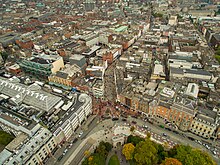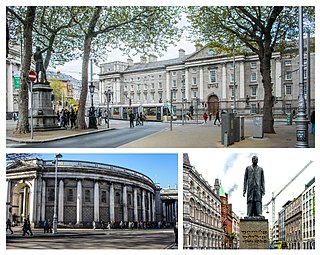
College Green is a three-sided plaza in the centre of Dublin, Ireland. On its northern side is the Bank of Ireland building, which until 1800 was Ireland's Parliament House. To its east stands Trinity College Dublin. To its south stands a series of 19th-century buildings.
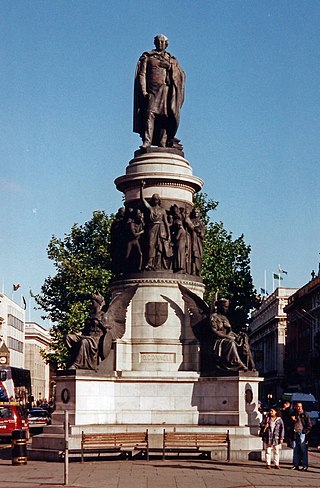
O'Connell Street is a street in the centre of Dublin, Ireland, running north from the River Liffey. It connects the O'Connell Bridge to the south with Parnell Street to the north and is roughly split into two sections bisected by Henry Street. The Luas tram system runs along the street.

"Molly Malone" is a song set in Dublin, Ireland, which has become its unofficial anthem.
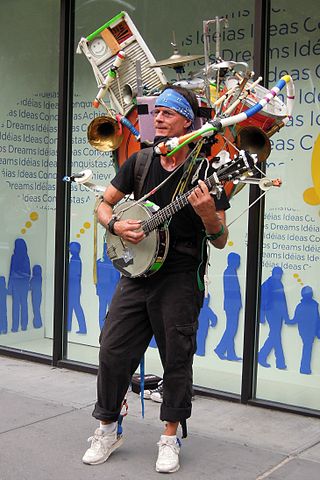
Street performance or busking is the act of performing in public places for gratuities. In many countries, the rewards are generally in the form of money but other gratuities such as food, drink or gifts may be given. Street performance is practiced all over the world and dates back to antiquity. People engaging in this practice are called street performers or buskers. Outside of New York, buskers is not a term generally used in American English.

Philip Parris Lynott was an Irish musician, songwriter, and poet. He was the co-founder, lead vocalist, bassist, and primary songwriter for the hard rock band Thin Lizzy. He was known for his distinctive pick-based style on the bass and for his imaginative lyrical contributions, including working class tales and numerous characters drawn from personal influences and Celtic culture.

Bewley's is an Irish hot beverage company, located in Dublin and founded in 1840, which operates internationally. Its primary business operations are the production of tea and coffee, and the operations of cafés. Bewley's has operations in Ireland, the UK and the United States; in the Boston area under the Rebecca's Cafe name and in California as Java City.

St Stephen's Green is a garden square and public park located in the city centre of Dublin, Ireland. The current landscape of the park was designed by William Sheppard. It was officially re-opened to the public on Tuesday, 27 July 1880 by Lord Ardilaun. The square is adjacent to one of Dublin's main shopping streets, Grafton Street, and to a shopping centre named after it, while on its surrounding streets are the offices of a number of public bodies as well as a stop on one of Dublin's Luas tram lines. It is often informally called Stephen's Green. At 22 acres (8.9 ha), it is the largest of the parks in Dublin's main Georgian garden squares. Others include nearby Merrion Square and Fitzwilliam Square.

Crumlin is a Southside suburb of Dublin, Ireland. Formerly a rural area, it became heavily built up from the early 20th century onwards. Crumlin is the site of Ireland's largest children's hospital, Our Lady's Children's Hospital.
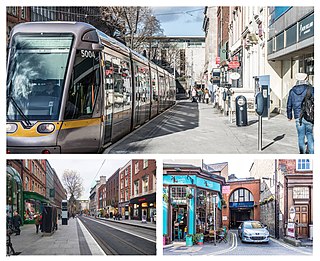
Dawson Street is a street on the southern side of central Dublin, running from St Stephen's Green to the walls of Trinity College Dublin. It is the site of the residence of the Lord Mayor of Dublin, the Mansion House.

Brown Thomas & Company Limited is a chain of five upmarket department stores in Ireland, located in Dublin, Cork, Galway, Limerick and Dundrum. Together with Dublin's Arnotts department store, it is owned by UK-based Selfridges, which in turn is owned by Thai Conglomerate Central Group and Austria's Signa Holding.
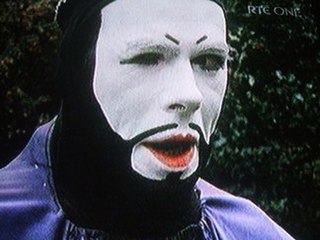
Thomas McGinty, known as The Diceman, was a Scottish-Irish actor, model, and street artist specialising in mime. Born in Scotland of Irish parentage, McGinty spent much of his life and career in Ireland, where he became a landmark living statue and one of the country's most popular street performers. He appeared in various plays and films, and through his work promoted political causes including gay rights in Ireland; he has been dubbed a "gay icon". He died in 1995 at age 42, from complications of AIDS.

Henry Street is located on Dublin's Northside and is one of the two principal shopping streets of Dublin.

Dame Street is a large thoroughfare in Dublin, Ireland.

Stephen's Green Shopping Centre is an indoor shopping centre in central Dublin, Ireland. Located on St Stephen's Green West, at the top of Grafton Street, it is named after St. Stephen's Green, a city park situated across the road from its main entrance.
The following is a timeline of events pertaining to the Troubles in Dublin, Republic of Ireland.

Allie Sherlock is an Irish singer, guitarist, songwriter, and busker. A video of her performing a cover of Ed Sheeran's "Supermarket Flowers" went viral on YouTube in June 2017. She appeared on The Ellen DeGeneres Show in 2018. Sherlock has performed frequently on Grafton Street in Dublin, Ireland.

The COVID-19 pandemic has had a deep impact on the Irish economy, leading it into a recession. Essential public health measures announced by the Irish Government to contain the spread of COVID-19 resulted in the largest monthly increase in unemployment in the history of the Republic of Ireland during March 2020. By 24 April, there were more than one million people in receipt of support interventions to the labour market, including those in receipt of the COVID-19 Pandemic Unemployment Payment and the COVID-19 Temporary Wage Subsidy Scheme. While there were job losses in all sectors, individuals working in tourism, hospitality, food and retail have seen the largest job losses.

RGRE Grafton Ltd v Bewley's Cafe Grafton Street Ltd and Bewley’s Ltd is an Irish legal case in the High Court between building owners RGRE Grafton Ltd and tenants Bewley's Cafe Grafton Street Ltd and Bewley's Ltd. The case related to non-payment of rent during the COVID-19 pandemic. RGRE sought a declaration that the stained-glass windows, designed by Harry Clarke) at Bewley's Oriental Café on Grafton Street in Dublin form part of the building and therefore belong to the landlord, as opposed to decorative panels that belong to the tenants.

College Street in Dublin follows the curve of Trinity College. It runs from College Green in the west to Pearse Street in the east. It lies in the "Mansion House A" Electoral Division of Dublin. It was described by the prolific engraver Mary Milner as "one of the most spacious of the noble thoroughfares of the Irish metropolis."



